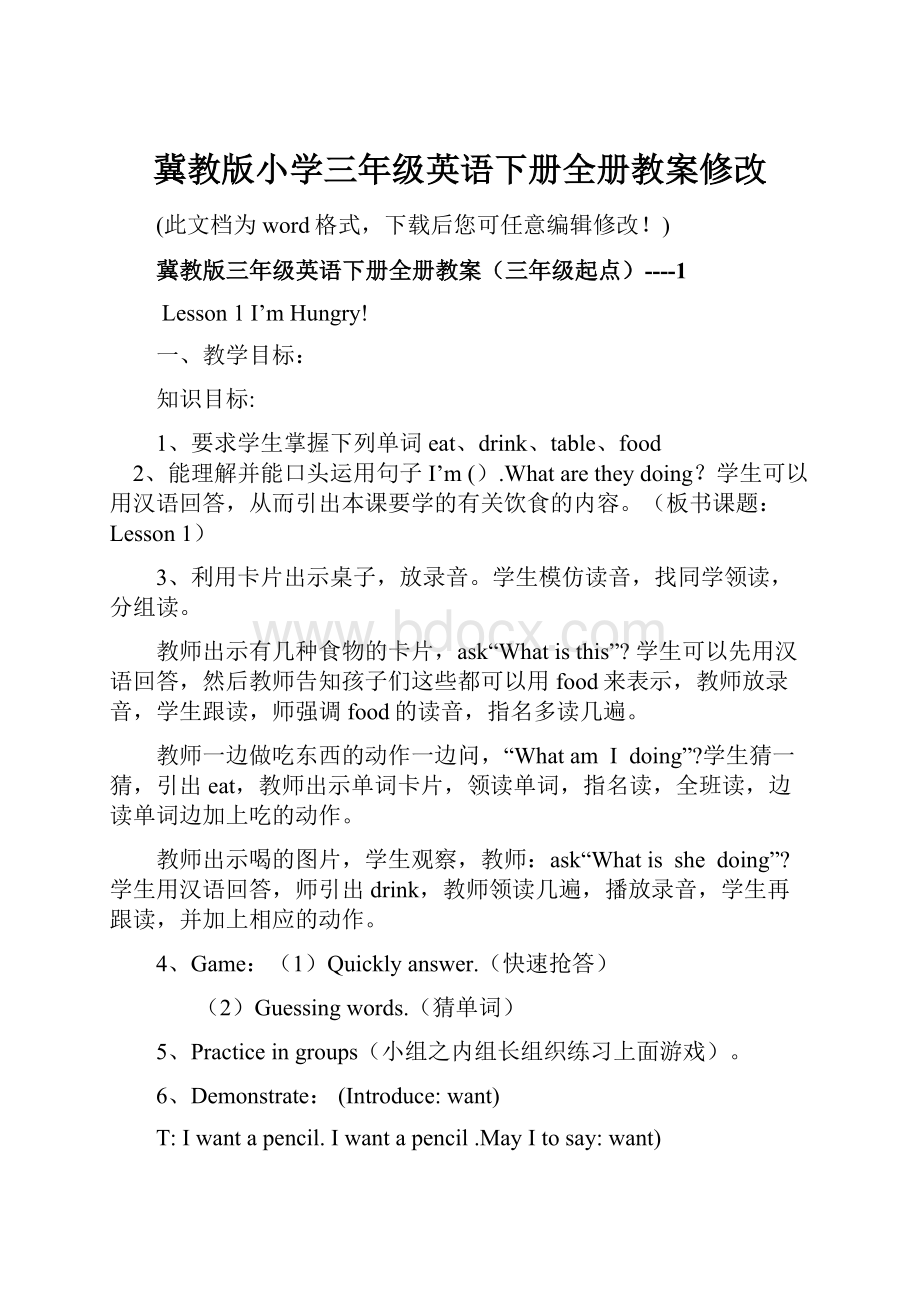冀教版小学三年级英语下册全册教案修改.docx
《冀教版小学三年级英语下册全册教案修改.docx》由会员分享,可在线阅读,更多相关《冀教版小学三年级英语下册全册教案修改.docx(68页珍藏版)》请在冰豆网上搜索。

冀教版小学三年级英语下册全册教案修改
(此文档为word格式,下载后您可任意编辑修改!
)
冀教版三年级英语下册全册教案(三年级起点)----1
Lesson1I’mHungry!
一、教学目标:
知识目标:
1、要求学生掌握下列单词eat、drink、table、food
2、能理解并能口头运用句子I’m().Whataretheydoing?
学生可以用汉语回答,从而引出本课要学的有关饮食的内容。
(板书课题:
Lesson1)
3、利用卡片出示桌子,放录音。
学生模仿读音,找同学领读,分组读。
教师出示有几种食物的卡片,ask“Whatisthis”?
学生可以先用汉语回答,然后教师告知孩子们这些都可以用food来表示,教师放录音,学生跟读,师强调food的读音,指名多读几遍。
教师一边做吃东西的动作一边问,“Whatam I doing”?
学生猜一猜,引出eat,教师出示单词卡片,领读单词,指名读,全班读,边读单词边加上吃的动作。
教师出示喝的图片,学生观察,教师:
ask“Whatis she doing”?
学生用汉语回答,师引出drink,教师领读几遍,播放录音,学生再跟读,并加上相应的动作。
4、Game:
(1)Quicklyanswer.(快速抢答)
(2)Guessingwords.(猜单词)
5、Practiceingroups(小组之内组长组织练习上面游戏)。
6、Demonstrate:
(Introduce:
want)
T:
Iwantapencil.Iwantapencil.MayItosay:
want)
7、(板书Iwantto…)Useactionstodemonstratethenewphrases。
T:
I’mtosay:
whatarethey saying?
听一听他们在说些什么?
播放录音,看图学习句子。
小组之内练习句子。
表现好的一组奖励金星。
10、课后练习:
(一)、连线:
eat、 drink、 food
(二)、选词填空:
1、I’m1I’mHungry!
2 Meat,ChickenAndFish
教学目标:
知识目标:
a.正确的听、说、口头运用食物单词meat、chicken、fish.
b.正确的听、说、口头运用数字单词eleven、twelve、thirteen、fourteen、fifteen。
c.能理解并能口头说句子Thisfoodisgood.
能力目标:
通过图片、词语和对话理解句子所表达的意思,让学生能口头运用句子表达自己的感情;能听懂简单的指令和要求做出适当的反应。
情感目标:
保持学生学习英语的兴趣和热情,鼓励学生将英语运用到生活中。
教学重点、难点:
本课的八个单词和句子。
教学媒体:
录音机和磁带、课件、教师用卡片、教学相关的图片或实物。
教学过程:
一.ClassOpeningandReview
1.Greeting.
Teacher:
“Hello,boysandgirls!
Howareyoutoday?
”(Encouragetheclasstoreply)
Class:
“……”
2.Singanumbersong:
“ONE,TWO,…”
Teacherandclasssingtogetherwhiledoingactions.
3.ReviewLesson1:
Watchthevideo“twocats”,Afterthevideo,asktheclasssayoutthesewordsandsentences“food,eat,drink”“I’m,fish.
T:
Aftersayingthevideo,Ifeelalittlespeakthefamiliarwords(forexample:
bananas,apples,pears,grapes),andthen,introducethenewwords:
meat,chickenandfish.Studychicken,fishonebyoneinorder.Encouragenonstandardstudentinpronunciation.
Practiceseveralmoretimetoreadthephoneticsymbolallow.
(通过反复朗读加深对单词的记忆。
)
T:
“WhatisDannysaying?
”Danny:
Thisfoodisgood!
Explain‘good’isawordwecandescribefoodphrase.Ifwelikeacertainfood,Wesaythe‘Goodfood!
’or‘Thisisgoodfood!
’.
(通过幻灯片展示,从视觉上让学生理解记忆。
)
GameTime:
(1)Usemorewordsthatyoulearned
(2)Usethethingsaroundyou
Practiceingroup
Passthegroupgame,practicethewords.
(游戏的练习,既调动学生的兴趣,将所学知识灵活运用于生活。
)
Playthetape,Askthestudentstopointtothepictureandreadthewordsonthebook。
(播放课文录音进一步巩固所学知识。
)
2.Numberseleventofifteen.
Demonstrate:
Useslidetoshow11pitches.Whenthestudentcountsthetentheteachersayseleven,twelve,Asktheclasssayafewtimesaftertheteacher.
Showthatthenextnumbers’ontheendtorepresent‘ten’.Studythirteen,fourteen,andfifteenonebyoneinorder.
(在数字单词的教学中,通过让学生找单词书写的规律来掌握它们的读音,进而记忆。
并通过数数的方式加以巩固。
)
Drill:
Letstudentcountingwithteacherfrom1to11,Thenletthemselvescountimmediatelyafter,Practiceagainandagaintwelve,thirteen,thirteen、fourteen,fifteen.
Game:
Theteacheruseslidetoshowpicturesandletstudentstoguessandcount“Whatisit?
Howmany?
”
(通过师生之间的猜谜游戏的练习,巩固数字单词。
)
三.ClassClosing.
Thestudentssingasong“one,two…”
Assign2Meat,ChickenandFish
1.(picturestoshowthewordsbelow)
meat chicken fish
2.eleven twelve thirteen fourteen fifteen
11 12 13 14 15
课后习题:
Chooseandtick.(挑出不同类别的一项)
( )1.A.warm B.cold C.good
( )2.A.father B.food C.mother
( )3.A.oranges B.pink C.purple
( )4.A.banana B.apple C.milk
( )5.A.one B.three C.meat
课后反思:
_______________________________________________________________________________________________________________________________________________________________________________________________________________________________________________________________________________________________________________________________________________
课堂教学资源:
把童话故事、歌谣、渗透在英语数字教学中
在我们现行的4A教材第三单元中出现了大量的数字()。
这么多的数字,怎么能让学生愉快的学习,而且能记得牢,并在生活中熟练的运用呢?
我试着采用童话故事的形式,给孩子们讲了关于数字的童话故事------数字妈妈为数字宝宝取名字。
1.复习1---12
我的个宝宝出生时模样各不相同,外貌相差很大,为他们起了不同的名字:
one,two,three,four,five,six,seven,eight,nine,ten,eleven,twelve.
这些数字娃娃要过生日了,我们为他们唱首歌吧:
One,two,three,four,
Howareyou?
Howareyou?
Fivesixseveneightnineten,
Howareyou?
One,two,three,four,
Howdoyoudo?
Howdoyoudo?
Five,six,seven,eight,nine,ten.
Howdoyoudo?
Iandtwelve.
我的13—19这些数字宝宝长的很相像,他们的头上张了同样的美丽的蝴蝶结,你们瞧,---teenthirteen,fourteen,fifteen,sixteen,seventeen,seventeen,eighteen,nineteen.
2.字卡出现这些单词,并用彩色笔把后缀---teen着重表现,突出出来并引起学生的注意。
通过学生观察发现,再由老师的适时引导,学生轻松自如的掌握了这些词。
3.宝宝出生时,他们都张了相同的长长的尾巴,猜猜看这是什么呢?
---ty,这组单词学生通过自我发现探究的方式,获取了新知识并从中得到的快乐。
4.用我们学习的数字表示身边常见的数字如:
电话号码,车牌号等。
进行一个小游戏活动。
由此发现,在教学中只要我们善于发现,采用一些孩子们感兴趣的童话故事、歌谣等形式,他们在轻松愉快的氛围中就会不知觉的学会了新知。
Lesson3WouldYouLikeSomeSoup?
一、教学目标:
1.要求学生掌握下列单词 noodles、dumplings、soup、rice
2.能理解并能口头运用句子
Wouldyoulikesome…?
Yes,please.No,thanks.
3.能在真实地环境中进行会话。
4.注意用餐中的礼节。
二、教学重点和难点:
本课的四个单词和句子。
三、教具、学具:
computers,radio,pictures,cards
四、教学过程:
Step1Warm-upRevision
(1) Let’schant.OK?
Tablefood,tablefood,
I’m)
(3)Makeadialogueusingthefoodpicturestheymeat.Whataboutyou?
B:
I’m
(1)Says:
I.
(2)Showthepictures:
noodle,dumplings,soup,rice.Letthemreadafteryouseveraltimes.
(3)Ask:
What’syourfavouritefood,noodles,dumplings,souporrice?
(4)Playaguessinggame:
Guess,what’sthis?
Ifyouareright,thepictureisforyou.OK?
(5)Presentthedialoguebyusingcomputerandsay:
TodayJennycomesLiMing’sletthemactitout.
(6)Says:
Doyouwanttobea“somemore”.Thenletthestudentssayafterthetapeorcomputer.
Step3Practice
(1)Practicethedialogueinthree:
A:
Wouldyoulikesome…?
B:
Yes,please.No,thanks.
A:
Areyouinterviewwiththeirfamiliesandfriendsusingthedialoguewethefoodyoulike.
五、板书 Lesson3Wouldyoulikesomesoup?
Noodles
dumplings
Wouldyoulikesome{soup ?
Yes,please.No,thanks.
Rice
课后反思:
课后练习:
1.连线
noodles dumplings rice soup
2.把句子填完整
Wouldyoulikesome----?
Yes,please.
课堂教学资源:
提供英国人早餐喜欢食品,区别于中国人的饮食习惯,渗透中西方文化的不同。
传统的英式早餐有煎培根、香肠和煎土司。
这叫做“煎食”。
4:
VegetablesandFruit
一、教学目标:
知识目标:
vegetables fruit morning afternoon evening
Doyoulike_____?
Ilike______. Idon’tlike_____.
能力目标:
能够表达自己喜欢或不喜欢的食物。
情感目标:
培养学生健康饮食,不偏食的习惯。
二、教学重难点:
学会使用句子:
Ilikedon’tlike______.表达自己喜欢什么食物。
三、教具学具:
蔬菜水果粘贴画,哭脸和笑脸卡片,学生自画的喜欢的食物图片,单词卡片等。
四、教学过程:
StepI:
GreetingandRevision:
1.Greeting
2.Sing“thefruitsong”
Playtheaudiotapetosingthesongtogetherasthestudentsshowtheirpictures.
3.Askstudentstointroducetheirfoodpicturestotheirpartnerstoexercise“Wouldyoulike_______?
Yes,please!
No,thanks!
”ifnecessary,theteachershouldgiveanexample.
StepII:
Newclass
PartI:
DoYouLikeThis
1.T:
Thisismypicture.Thisis_____.(Pointtoonefruitinthepicture)Ilike_____.(Showthe“like”.)wouldyoulike______?
S:
Yes,please.No,thanks.
T:
Ilike______.(Show’tlike______.(Showthesadface) Doyoulike_____?
S:
YesNo
2.Askstudentstoexercisewiththeirpicturesinpairsliketheteacher,thenshowinfront.
3.Gamenamed“FindingFriends”
用两套相同的食物卡片分发给同学们,请他们用Doyoulike_______?
句型问其他的同学,当问到和自己手里卡片食物名称一样的同学时就找了到自己的朋友。
4.Playtheaudiotapeasthestudentsfollowintheirbooks.
PartII:
1.Pleaselookatthebookandguesswhatthepictureareabout.
(Theteachersaythesentencesanddotheactionto,evening.Ifnecessary,wecanexplaininChinese.)
2.Playtheaudiotapeasthestudentsfollowintheirbook.
3.Workinpairs:
Talkaboutwhattheydointhemorning,afternoonandevening.
4.Playagame:
告诉每行第一个同学一个单词,然后传到最后一个同学,再请最后一个同学在黑板上画出他所听到的,请第一个同学猜,当然最后一个同学不能说。
看哪组同学传得快,猜得准。
(可使用我们已学过的蔬菜水果的单词,重点复习本课学的单词)
五、Blackboard:
Lesson4:
VegetablesandFruit
Ilike_______. Wouldyoulike_______?
Idon’tlike______. Yes,please!
No,thanks!
六、课后反思:
七、练习
听力
选择听到的单词
1. ( )Alunch BdumplingsCdrink
2. ( )Afifteen Bsupper Cvegetable
3. ( )Afish B+four=Athirteen.BelevenCtwelve.
2. Igetupinthe__________A.morningB.afternoon
3. Idomythe______Aevening.Bafternoon.
4. Intheafternoon,IeatAlunch.Bsupper.
二.情景交际(20分)
1.我喜欢吃鱼,应该说()
A.Ilikefish.
B.Ilikemeat.
2.我不喜欢蔬菜,怎么说( )
A..Idon'tlikevegetables.
B.Ilikevegetables.
3.用英语表达“你喜欢吃水果吗?
”A.doyoulikevegetables?
B.Doyoulikefruit?
听力材料:
1dumplings2vegetables.3juice.
4.thirty.5.evening.
八、课堂教学资源
morning
上午是指从早上起床,一直到到中午吃饭这段时间。
在中国,早上和上午是不同的概念,早上一般指8点钟以前。
而英文没有早上的概念,在英文的逻辑当中,从起床到中午吃饭这段时间,是同等重要的,不需要区分。
earlyinthemorning
一大早,早晨
noon
中午,正午 12点钟的时候,而不是中文的“12点到1点”的含义。
afternoon
下午 是指从中午12点后到晚上6点左右
evening
晚上从晚上6点以后一直到睡觉的时间
night
指天黑之后一直到第二天的天明,通常是指到你睡觉的时候。
Lesson5 BreakfastLunchandSupper
一、教学目标
1、知识目标
(1)能正确的说、认识和口头运用下列单词:
breakfastlunchsupper
(2)能够向他人介绍自己最喜欢的食物,并在生活中灵活运用:
Myfavouritefoodis________.
2、能力目标